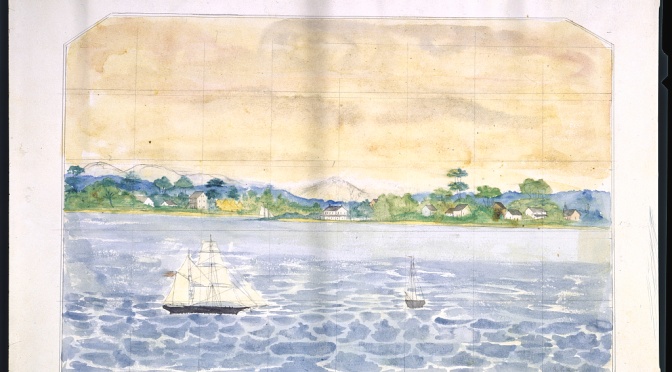The ostensible primary purpose of the African squadron, according to the terms of the Webster-Ashburton Treaty, was to regulate the slave trade and prosecute slave ships flying the American flag. But given the logistical challenges of regulating roughly 2,000 miles of coastline, the African Squadron never encountered any slave ships flying the American flag – a fact that Commodore Perry dutifully reports in each letter to the Secretary of the Navy.
As a result, the squadron was free to focus their attention on monitoring American settlements and trading activity in Africa, and ameliorating relations with the African native tribes. In fact, these activities account for most of Bridge’s journal and Commodore Perry’s reports to the Naval Secretary.
In the early 1840s, relations between Americans and native Africans became increasingly strained. Liberian settlers and merchant ships feared for their safety, and several violent incidents prompted Naval Secretary A.P. Upshur to request Congress for funds to establish a permanent naval presence in Africa to ensure the safety of Americans. Two of these incidents involved violent attacks on merchant vessels: The Edward Burley and the Mary Carver.
Each of these events involved an American merchant vessel whose crew members were murdered by African natives. Despite the understandable fear and outrage these events prompted, they proved challenging to investigate. By the time that Commodore Perry and Governor Roberts of Liberia convened palavers in November and December of 1843, considerable time had elapsed since the events – in the case of the Mary Carver, almost a year and a half. The minutes from the palavers in these cases suggest that some of the involved parties are dead or no longer living in the area. As a result, the accounts of the incidents are reconstructed from second and third-hand sources. Kings are called upon to answer for the conduct of their people, and first-hand witnesses are virtually absent.
These accounts offer some of the earliest attempts to articulate America’s role as a colonial power and grapple with her nascent identity as a sort of world police. The authors of these accounts, for the most part, see America as culturally, morally, and intellectually superior to Africans. But at times they struggle with how America ought to convey that superiority. During the deliberations over how to punish the perpetrators of the Edward Burley attack, Commander Josiah Tattnall wonders, “should those who have the advantage of more cultivated morals judge of them too harshly?” (Perry 11). After the Americans burn the villages at Little Berribee, the Hawthorne-Bridge narrator muses, “one would fain hope that civilized man, in his controversies with the barbarian, will at length cease to descend to the barbarian level, and may adopt some other method of proving his superiority, than by his greater power to inflict suffering” (Journal 85). Thus, these accounts demonstrate a tension between a desire to justify America’s actions towards the Africans, and uncertainty as to what degree their actions are appropriate and justified. Further exacerbating this tension is the absence of any African voice from the record of these events. Bridge, Hawthorne, and others convey uncertainty over the precise circumstances of the two clashes, but they stop short of recording any native African version of the incidents.
The pages linked at the left explore various accounts of the incidents of the Edward Burley and the Mary Carver. Each page provides a brief synopsis of the event, along with a gallery of images displaying excerpts of various accounts taken from Bridge’s manuscript diary, the published Journal, Commodore Perry’s letters to Congress and accompanying documentation, and contemporary newspaper and magazine articles. The reader may find that browsing through these accounts is confusing and even disorienting. We would like to suggest that that is precisely the point. The process of reconstructing the original truth of these incidents is frustrating, disorienting, and somewhat circular. Moreover, the total absence of native accounts represents an irreparable gap in the narratives.
